Business Community
In the Margins | Braving auction anxieties in support of Gig Harbor’s working waterfront
To be honest, I have always found auctions to be a bit intimidating. I tend to second-guess myself about whether to bid for stuff, how much to bid for stuff, and what to do with the stuff if I do emerge an unlikely winner. While my fellow bidders enjoy the sporting gamesmanship, I nervously fret about the commitment of raising my hand or, more likely these days, clicking my computer mouse.
To bid or not to bid, it’s my anxiety trigger.
Recently, I confronted these mild fears after attending a local community fundraising auction for the Gig Harbor BoatShop, a local nonprofit aimed at keeping alive Gig Harbor’s legacy of a working waterfront.
I figured if the ancient Greeks and Romans could conduct auctions as far back as 500 B.C., I should suck it up and attend. Apparently, during the 17th and 16th centuries, the Brits used wax candles as timing devices for auctioning off ships. When an inch-long candle burned itself down to fumes, the auction was declared done. Someone sailed off with a newly prized vessel – or so Samuel Pepys, administrator of the Royal Navy during the 1660s, described it in his diary.
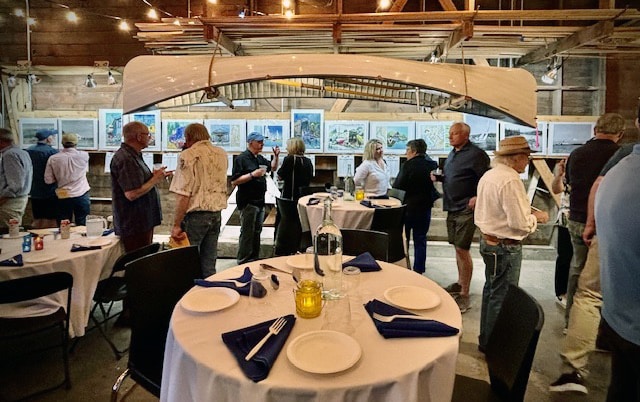
Pre-game conversations provided sufficient warmup for the live auction. Photo by Chris Phillips
For lack of a Royal Navy, Gig Harbor replaced candles with an abundant no-host bar, tasty hors d’oeuvres (bacon and smoked salmon are usually involved), and a clipboard on which bidders stealthily compete for the items on display. The stealth auction is often accompanied by a good-natured live auction akin to what you might see at Christie’s or Sotheby’s, minus that pretentious fellow with the velvet blazer and gavel.
Unofficial guide to a successful auction
During the BoatShop’s annual May auction, I saw no sign of velvet blazers or gavels. All the boatbuilding tools, sawdust and varnish were carefully stowed, and the cavernous, beamed innards of the historic Eddon Boatyard were transformed into an inviting party venue complete with gallery lighting and eye-catching displays of maritime art and artifacts. Some 130 guests mingled amid displays, and the place buzzed with conversation in anticipation of the auction’s main event.
As the evening unfolded, my auction anxiety gave way to some clear realizations of what it takes to pull off an effective, fun community fundraiser. With apologies to Sotheby’s, here’s an unofficial four-step guide to staging a successful auction:
Common DNA
When you live in a place with a last name of “Harbor,” it’s a good bet that boating is deeply anchored into the community psyche. Perhaps you have signed up to help restore the Shenandoah fishing boat at the Harbor History Museum. Or maybe you just glide around in a kayak at the sandspit near the mouth of the harbor.
Even if you don’t know your starboard from your ironing board, you probably have a good boat story to tell – or one to repeat. The room was full of boat stories at this auction. It’s what everyone had in common. And rumor has it that a few of the stories might have been true.
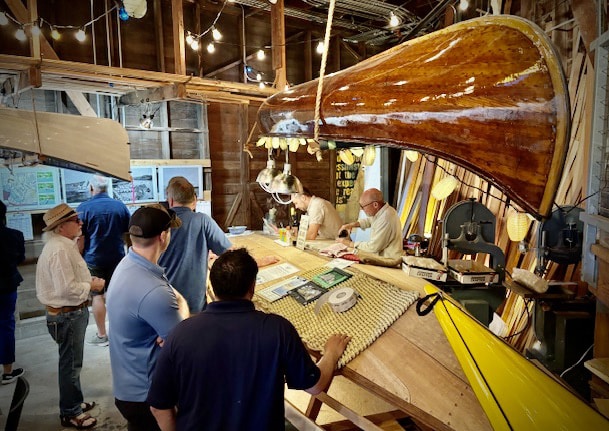
An overturned wooden boat also serves as a no-host bar for supporters. Photo by Chris Phillips
A charismatic character
Every auction requires a ringleader to harness the energy in the room. It takes a stream of incentivizing banter and just the right dose of biting good humor.
Self-taught auctioneer Jim Borgen, a native son to Gig Harbor and a familiar face and voice to many locals, is type-cast nicely for the role. He spontaneously started his side gig of auctioneering 25 years ago at a work gathering when one of his college fraternity brothers was diagnosed with juvenile diabetes.
Since then, he has contributed his popular auctioneering to many local nonprofits and community groups. His callouts and light-hearted jabs at those in the audience have led the BoatShop’s auctions each year since the events were started.
“This one is right up my alley because I know almost every person in crowd,” said Jim, who rarely uses a script. “My approach is very off-the-cuff. It’s less about the auction and more about having fun by engaging people.”
Those who become targets of Jim’s jokes know whereof he speaks, and they are probably still chuckling from his well-landed zingers. Those who knew Jim’s father, George Borgen, and can fondly remember his local landmark hardware store, know precisely where Jim’s relentless but affectionate humor originated. When George was in the room, no one was safe from hometown satire.
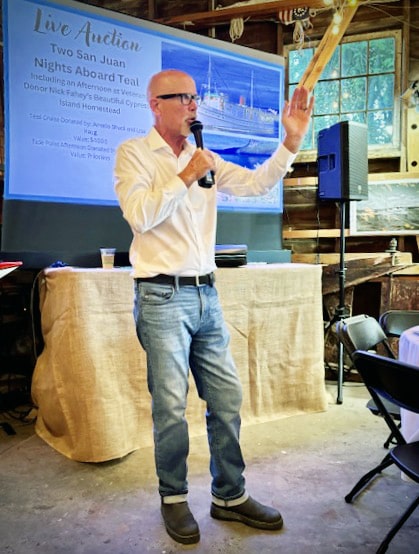
Self-taught auctioneer Jim Borgen blends active bidding with a good-natured roast of those in attendance. Photo by Chris Phillips
Roll up some sleeves
The lifeblood of any fundraiser requires people in the trenches to come forward to welcome outsiders. At the BoatShop auction, I met retirees Matt Hucher and Bob “Stubby” Huey, two volunteers with the Family Boat Building program. They guide classes in which anyone who signs up can build a 12-foot Salt Bay skiff during a single weekend of hands-on woodwork. They immediately ushered me into the upper level of the boathouse to show me where these “family” boats are crafted.
Amid stacks of carefully cut veneered plywood and hardwood brackets, they explained that they have been helping various family groups to build about six boats per year. The shop has seen more than 200 of the dinghies go home with local families.
“We’ve had three generations of a family working together on their boat,” said Bob. “The program fills up every year. We’ve had single women with their kids building the boats, and with some families we find the moms are better at this than their husbands.”
“We just enjoy messing around with wood. It keeps us out of the house — something that’s very important for our wives,” said Matt with a knowing grin.
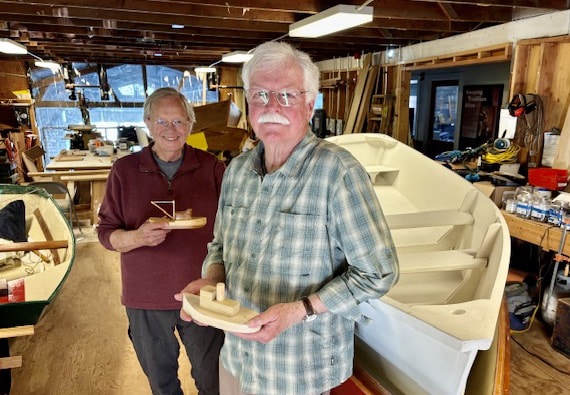
Matt Hucher and Bob “Stubby” Huey help keep the Family Boat Building program on course. Photo by Chris Phillips
The duo still marvels when talking about one 8-year-old girl who worked hard on the boat project all weekend and then stayed to help sweep up the shop. “She was just amazing,” said Bob.
Education dressed as entertainment
Any successful fundraiser wants people to leave knowing more about the organization than when they arrived. This gets tricky because no one wants to sit through a TED talk or, heaven forbid, a 30-page Powerpoint on the updated strategic plan.
Local videographer and BoatShop staffer Trevor Nordeen answered the call at the auction with an 11-minute video slide show depicting all the activities of the organization. It worked well because some aspects of the BoatShop’s activities have remained out of view even for those involved in the organization.
The show reminded everyone that there’s more going on than meets the eye. It was a lively level-set for everyone in the room. Many attendees offered a verbal thumbs-up review of the show during the remainder of the event.
Good photos and some snappy narration go a long way toward disguising education in a comfortable coat of entertainment.
Energizing the good work
If you get these ingredients right, auctions work. It’s no wonder so many of our mission-driven community groups rely on these events to stimulate charitable giving. When done well, auctions help these organizations and their supporters to draw closer; the stakeholders gain energy and commitment for continued good works.
That initial uncertainty of whether the auction will work, or how well it might work, tends to motivate people to come together to give of themselves collectively and to prove a point — that the cause is worth it! Auctions allow supporters to donate more than just their goods, services and money; they give public testimony for something that matters to them.
BoatShop Director Guy Hoppen and the group’s Board of Directors have been staging auction events to raise funds annually since 2012. They missed a couple years during the COVID-19 gap but resumed in 2023. This year’s auction raised more than $75,000 for the BoatShop’s programs, operations, and maintenance.
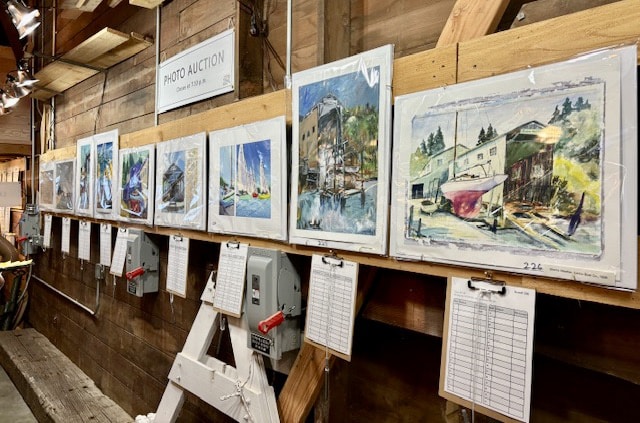
The silent auction featured many local artists’ “boatscapes”.
‘Everything clicked’
The live auction featured only 13 spotlighted items — everything from a shiny pair of sea kayaks to donated get-aways to Alaska or the San Juan Islands. The silent auction featured artwork, woodwork and more than 30 of Ken Ollar’s historic black-and-white maritime photos from archives that the BoatShop’s Northwest Fleet Documentation program is digitizing.
“Everything clicked this time,” said Guy. “We had a lot of good energy when people sat down for the auction. I think we’ll stick with it.”
After my evening at the BoatShop, I found myself wondering why I had been anxious about this entertaining process of bidding for stuff in a room full of local friends and acquaintances. Better yet, Matt and Stubby convinced me to lend a helping hand with the Family Boat Building crew – a decision they may live to question. Before leaving, I also checked the silent-auction clipboards to see whether I was going home with any boathouse relics that might require an explanation to my wife. Whew, I was outbid!
Want the video narrative?
Trevor Nordeen’s video as shown during at the event.
Maritime summer camp scholarship for girls
Local boater Jamie Hatten is making boating accessible for young girls.
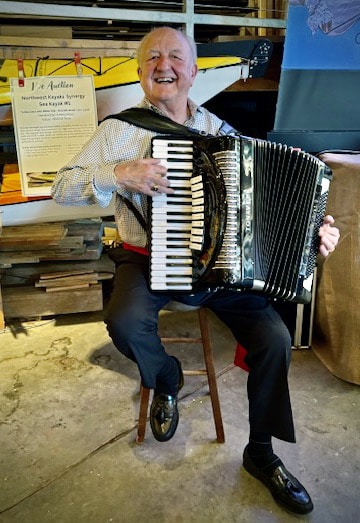
Accordion Maestro Andy Mirkovich provides the soundtrack. He was a featured performer at the Seattle Space Needle and deep family ties to Gig Harbor’s fishing families. Photo by Chris Phillips

